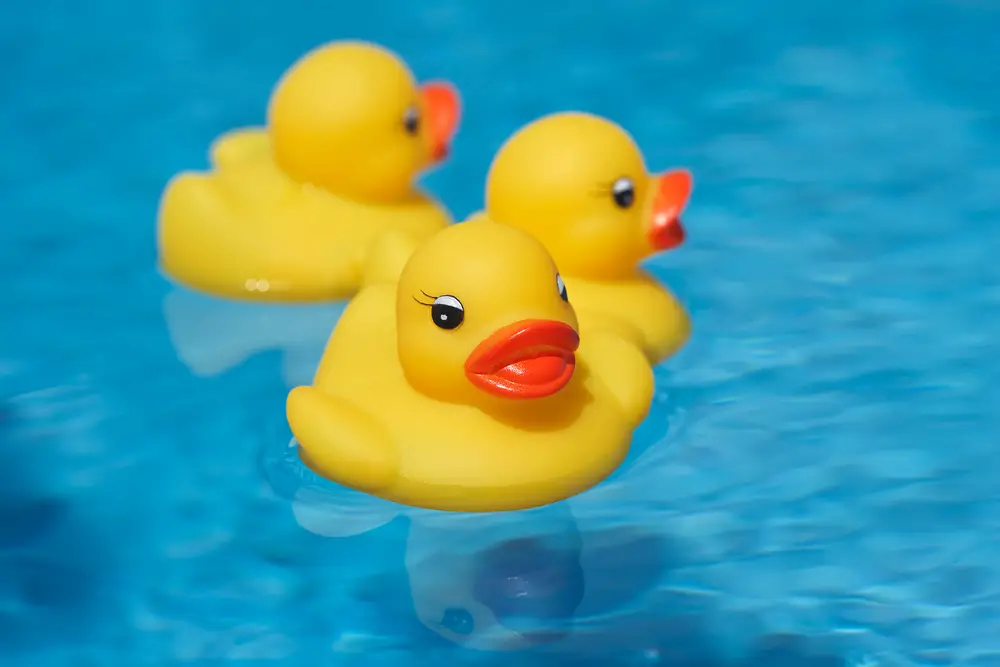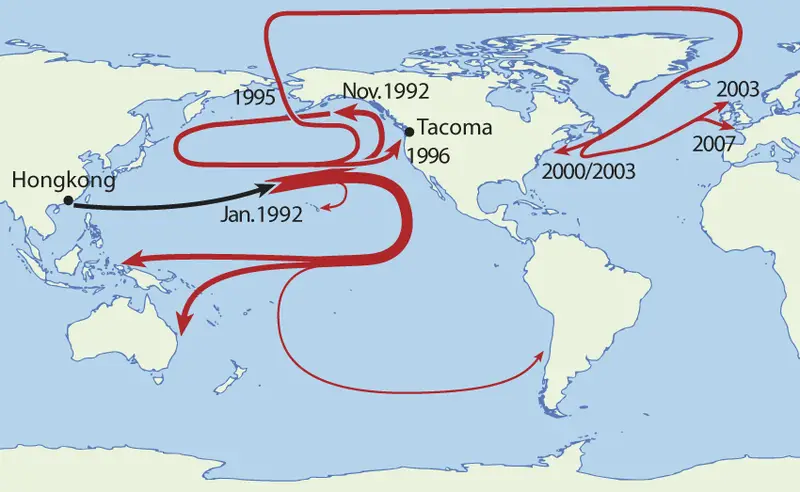
In 1992, over 28,000 plastic bath toys took a journey of epic proportions after they were washed off a container ship and into the Pacific Ocean. While the release of plastic objects into the ocean can be detrimental to the ecosystem, this particular incident proved to aid in the study of ocean currents, how they change over time, and where all that plastic goes when it is in the ocean.
How Those Ducks Got Off the Boat
The bath toys started their journey in Hong Kong on a container ship called the Ever Laurel in January 1992. The toys had been made for The First Years Inc. and were destined for Tacoma, Washington. When the ship was about halfway through its journey, a storm hit the vessel in the North Pacific Ocean which washed twelve 40-foot containers overboard. In one of the containers were the bath toys for The First Years.
The container opened somehow and released 28,800 yellow ducks, red beavers, blue turtles, and green turtles. The toys had been attached to a cardboard backing, but it soon degraded in the ocean which allowed the objects to float freely. In addition, the toys had no holes in them like other bath toys, so no water got inside them.
The Journey
The yellow ducks, along with the other toys, began a journey around the world’s oceans, aided only by the ocean’s current and where it would take them. The toys first appeared on shore in late 1992 off the coast of Alaska, around 2000 miles from where they started their journey.
Oceanographers Curtis Ebbesmeyer and James Ingraham started tracking the ducks to better understand the surface currents of the ocean. The number of floating objects had a significant advantage over other methods for tracking ocean currents since the recovery rate would be significantly higher.
The two scientists had already been tracking other floating objects in the ocean, such as a swath of 60,000 Nike shoes that had been washed overboard in 1990, 5 million LEGO pieces, and 34,000 hockey gloves. When someone found a duck on a beach, the scientists would plug the data into a system Ingraham had been using at the NOAA fisheries in Seattle called the Ocean Surface Current Simulator. They then began to predict where the ducks would end up next.

The toys began to circulate around the North Pacific Subtropical Gyre, a circulation that is responsible for the Great Pacific Garbage Patch. They were then discovered in Washington State, Canada, Japan, and Hawaii. By 1993 and 1994, the ducks and their friends began moving toward the Arctic Ocean where they would eventually travel on ice packs. As the ducks made it to Greenland, they entered into the Atlantic gyre and the currents of the Atlantic Ocean. They reached the east coast of the U.S. between 2000 and 2003.
As the ducks floated in the Atlantic currents, it was predicted they would reach the United Kingdom. They were discovered on the beaches there between 2003 and 2007 after completing a 15 year, 17,000-mile journey. Some were even discovered as far south as Australia, South America, and even South Africa.
Where They Go From Here
The information from the “Friendly Floatees,” as they have been dubbed, has been invaluable to the understanding of how the ocean currents work and predictions of where things will go. Many of the ducks are still out there. About 2,000 are still floating in the Great Pacific Garbage Patch, and some are probably still trapped in the ice of the Arctic.
The ducks have even inspired some other works. Eric Carle, the author of The Very Hungry Catepillar, wrote another children’s book about the “floatees” called 10 Little Rubber Ducks, and writer Donovan Hohn wrote an entire book about the incident called Moby-Duck: The True Story of 28,800 Bath Toys Lost at Sea.
Sources: Washington Post, New York Times, NPR, The Sun, Daily Mail, MNN, CNN, The Guardian

